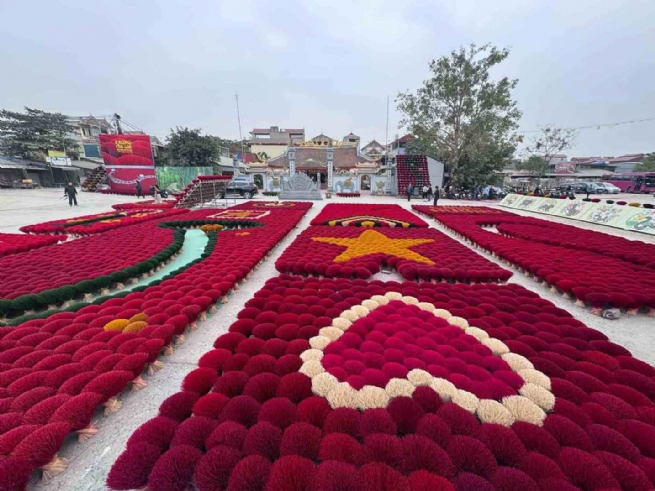The incense-making craft in Quang Phu Cau village has existed for nearly a century and is closely linked to the legend of the three female generals Chieu Nuong from the time of the Trung Sisters. From a traditional craft serving domestic needs, the village has now expanded production for export and experiential tourism, bringing its handmade products closer to international markets.

The incense production involves meticulous handmade processes
Visitors entering the village are immediately greeted by the distinctive fragrance of resin, spreading through the air. Under the sunlight, the colorful bundles of incense sticks create a signature scene that has made the centuries-old craft village famous.
Agriculture was once the main livelihood of residents in Ung Thien commune, Hanoi. However, as urbanization has reduced agricultural land, the traditional incense-making craft has found new opportunities to thrive. It has significantly contributed to job creation and income growth for local people, helping improve living standards. Alongside incense making, residents of Ung Thien have also engaged in side jobs such as scrap trading and construction work. Yet since around 2010, incense production has revived and developed rapidly in all hamlets. As production expanded and new markets were explored, the need for cooperation naturally led to the formation of collective business models, especially traditional incense-making cooperatives, which have since thrived.
One notable example is the Xa Cau Incense Production Cooperative, located in Xa Cau hamlet, Ung Thien commune. The cooperative is well-known for its scale, management model, and economic efficiency in producing traditional black incense. According to Director of Xa Cau Incense Production Cooperative Nguyen Tien Thi, a native of the village, his deep understanding of the craft’s heritage inspired him to establish and develop the cooperative model.
“Many stages of incense making still require manual work and cannot be replaced by machines,” Thi explained. “For example, dyeing the incense sticks must be done by hand, as machines cannot tell which areas need deeper color or when to stop. Even after the sticks are polished by machine, they must still be handled carefully by hand to keep them straight and even; otherwise, they bend and break easily.”

Ensuring the incense sticks are fully sun-dried
While machinery has helped increase productivity, many distinctive steps of the incense-making process remain entirely manual. Drying incense, for instance, depends heavily on the weather. On days with sudden rain or prolonged humidity, workers must stay alert to move, cover, and adjust drying racks in time. “Every day brings different weather,” Thi said. “You have to calculate and adapt constantly. That’s something machines can’t do.”
Starting with 12 members, all skilled artisans and experienced incense makers, the Xa Cau Incense Production Cooperative has produced traditional incense that maintains the craft’s authenticity in both scent and design. At the same time, to meet modern demands, the cooperative has invested heavily in technology, helping increase output and ensure product consistency while creating new export opportunities.
The craft village model, supported by well managed cooperatives such as the Xa Cau Incense Production Cooperative led by Nguyen Tien Thi, is entering a new phase: traditional incense production combined with tourism services. The decision by the Hanoi People’s Committee to recognize “Quang Phu Cau Incense Stick Craft Village Tourist Site, Ung Thien Commune, Hanoi” marks an important milestone. It affirms the village’s tourism potential and cultural value, creating momentum for local economic development.
The brightly colored drying yards have become popular check in spots that attract photographers and tourists. Artisans arrange bundles of incense sticks into shapes such as the map of Vietnam, the red flag with a yellow star, flowers, and decorative motifs. Even the Vietnam map is recreated in various styles with different color arrangements. One common design leaves an empty space in the center, with incense bundles forming the border and background so that visitors can stand in the middle of a “forest of incense” for photos. This creativity, combined with strong promotion on social media platforms, has helped transform Quang Phu Cau into a unique destination for both domestic and international travelers.

The colorful bundles of incense sticks create a signature scene that has made the centuries-old craft village famous
However, as with any craft village, environmental concerns have emerged. Alongside investments in modern machinery, both city and commune authorities need to support comprehensive planning, land allocation for workshops, communication efforts, and guidance for cooperative members to ensure sustainable production practices that protect the living environment. This is essential for maintaining a welcoming space that encourages tourists to visit and return.
Beyond preserving a century-old heritage, Quang Phu Cau incense village is gradually establishing its presence in international markets. Incense sticks made from bamboo and neohouzeaua, traditional materials of the Red River Delta, are now available in countries such as the United States, Myanmar, Thailand, Malaysia, Nepal, Pakistan, and several markets in the Middle East.
Yet the journey to global markets is not simple. Each country and culture uses incense differently, and each imposes strict standards on quality and raw materials. Vietnamese incense sticks have strong potential to expand further and become not only consumer goods but also cultural ambassadors of the nation.
By Dinh Bao, Vietnam Business Forum
| This special section is supported by Hanoi Coordination Office of the New Rural Development Program |